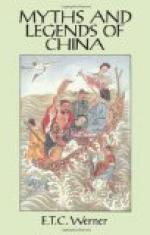In the third century B.C. began the hostile relations of the Chinese with the northern nomads, which continued throughout the greater part of their history. During the first six centuries A.D. there was intercourse with Rome, Parthia, Turkey, Mesopotamia, Ceylon, India, and Indo-China, and in the seventh century with the Arabs. Europe was brought within the sociological environment by Christian travellers. From the tenth to the thirteenth century the north was occupied by Kitans and Nuechens, and the whole Empire was under Mongol sway for eighty-eight years in the thirteenth and fourteenth centuries. Relations of a commercial and religious nature were held with neighbours during the following four hundred years. Regular diplomatic intercourse with Western nations was established as a result of a series of wars in the eighteenth and nineteenth centuries. Until recently the nation held aloof from alliances and was generally averse to foreign intercourse. From 1537 onward, as a sequel of war or treaty, concessions, settlements, etc., were obtained by foreign Powers. China has now lost some of her border countries and large adjacent islands, the military and commercial pressure of Western nations and Japan having taken the place of the military pressure of the Tartars already referred to. The great problem for her, an agricultural nation, is how to find means and the military spirit to maintain her integrity, the further violation of which could not but be regarded by the student of sociological history as a great tragedy and a world-wide calamity.
Physical, Emotional, and Intellectual Characters
The physical characters of the Chinese are too well known to need detailed recital. The original immigrants into North China all belonged to blond races, but the modern Chinese have little left of the immigrant stock. The oblique, almond-shaped eyes, with black iris and the orbits far apart, have a vertical fold of skin over the inner canthus, concealing a part of the iris, a peculiarity distinguishing the eastern races of Asia from all other families of man. The stature and weight of brain are generally below the average. The hair is black, coarse, and cylindrical; the beard scanty or absent. The colour of the skin is darker in the south than in the north.
Emotionally the Chinese are sober, industrious, of remarkable endurance, grateful, courteous, and ceremonious, with a high sense of mercantile honour, but timorous, cruel, unsympathetic, mendacious, and libidinous.
Intellectually they were until recently, and to a large extent still are, non-progressive, in bondage to uniformity and mechanism in culture, imitative, unimaginative, torpid, indirect, suspicious, and superstitious.
The character is being modified by intercourse with other peoples of the earth and by the strong force of physical, intellectual, and moral education.




